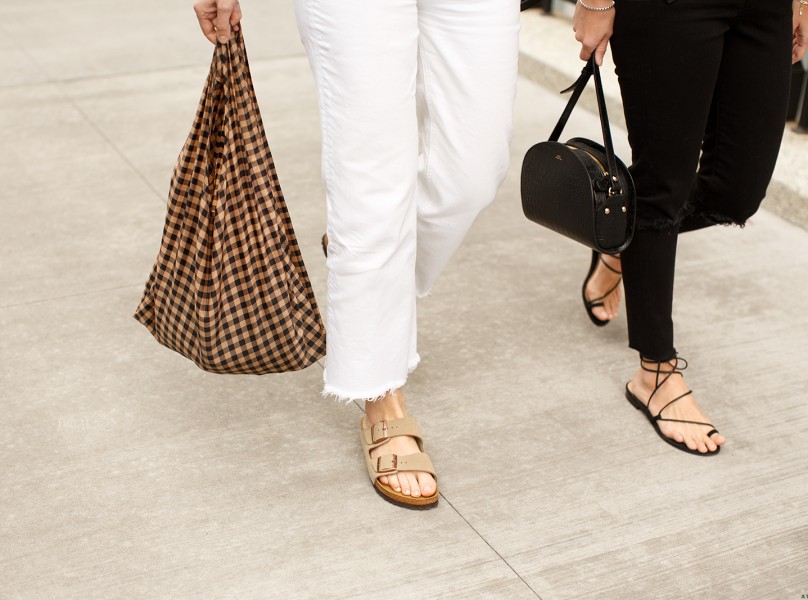How To / Botox
7 years ago by
The recent #10-year challenge craze on Instagram involves posting photos of oneself today and from a decade ago. Whether photo filters, cosmetic procedures or neither are involved, many participating look ageless. The same can’t be said about me. I’ve never tried Botox because I’m mostly okay with my wrinkles. Unless it’s medically necessary, I’m reluctant to choose needles or uncomfortable procedures because I’ve had health issues. Recently, however, the 53-year-old staring back at me in the mirror is becoming less recognizable.
I don’t regret aging naturally, yet I was a little nervous meeting Lisa Goodman, PA and Founder of GoodSkin, based in Los Angeles and New York City. Lisa specializes in an “Untouched Look,” which she achieves through European methods picked up during her training in Paris and the Netherlands. After assessing current photos of my parents and factoring in that I‘ve had zero preventive work, Lisa recommended Sculptra Aesthetic, an injectable collagen stimulator that helps with volume loss. The cost: about $10,000. It’s a tempting option to turn back time, but with a college tuition to finance soon, I have to take a pass.
For some though, a priceless perk gained after a face refresh puts this whole aging thing in perspective. Lisa has a client with cancer who sees her every two months. The reason she never misses an appointment: “People constantly tell me I look rested. For no one to tell me I look sick when I’m really sick is a helpful reminder that I’m alive.”
What’s the difference between the European approach to cosmetic procedures vs. an American approach?
Nurses, nurse practitioners and physician assistants in Europe are not able to give injections. A lot of times you go into a practice and it’s one doctor and one nurse in a room. They are already set up to be a more consultative experience where you spend time diagnosing, making a plan based on the science of aging for a person to look more rested, more beautiful. I went to Paris in 2014 to shadow Dr. Pierre-Alain Mayeux and Dr. Claude Aharoni, a plastic surgeon. I came back from my trip and said to my boss at the time, ‘this is how we have to do it.’
In Europe, there are better training courses. You learn injections, threads and the science of aging on cadavers. It’s science-based, anatomy-based. Anyone injecting in our office completes a clinical facial anatomy course in the Netherlands. I take my nurses and office staff every year to a conference in Monaco. The way they talk about these things medically is definitely the way I’ve talked about it vs. in the U.S., there is a conference in Las Vegas which is very much about point and shoot.
American clients will call and say, ‘I want filler.’ European clients will call and say, ‘I want a diagnostic.’
Explain the science of aging. How does this impact your practice?
There are five parts: bone, muscle, fat, skin, fascia. Fascia is like the spanx of your face. It is your connective tissue. Think of it as the white stuff around the chicken holding all of your structures together.
Then you have fat that’s layered in two different compartments: superficial and deep. People think that there’s just fat everywhere. There’s not. There are actually compartments of fat.
And then you have skin and more connective tissue. Science of aging everything shrinks– bone, skin. There was this old idea that skin got loose. That’s actually been disproven. It’s not that skin gets loose; it’s that you lose all the support for the skin. The other thing that happens is fat will drop and redeposit in lower places. As soon as you stop growing you start aging.
Areas of the face where the bones are more stressed by muscles are where we have less bone loss. Areas where the face is less stressed we have more bone loss. Stressing the bone earlier in life will help preserve bone structure. I can’t create more bone but I can use filler to create the look of more bone on someone in their ‘60’s.
Someone in their 20’s, I can literally preserve bone for them. You can completely preserve collagen with lasers, you can completely preserve fascia with lasers, and then in terms of fat, that’s the subcutaneous layer where you have two layers, you can’t preserve fat. Fat does leave, generally, on most people’s faces or drifts down no matter what you do, but by adding small amounts of fillers earlier on, you basically have to do less later.
And those fillers do create collagen, but collagen isn’t really fat. They’re very different things, but you can preserve all those things. For muscles, if you spend time earlier on making a muscle that is strong, that muscle will never get to that sagging point later in life. It’s good muscle memory.
How do you incorporate someone’s family history, such as photographs of your parents, into a diagnostic?
Each part of aging has a different tool. The best way for someone to preserve how they look or slow down the aging process is to understand what their main component of aging is.
We tell clients to bring photos of their parents when they’re around 50. You’ll see in families, especially around 50, 60, something that usually stands out. Families with thinner faces will have all over volume loss. Some families have looser necks or under-eye bags. You’ll just see one of those things stand out at an earlier time before it all stands out. But you can also see things like families with really strong cheekbones.
Why do I feel like I’m aging rapidly and looking older than my peers?
What’s interesting is we’re now more astute to aging, meaning that people’s eyes are more critical due to selfies, Instagram, videos. The standard of beauty has all of a sudden shifted. It was probably always like that in L.A. which is a youth driven place due to the movie business, but you’re probably seeing that filter out to more parts of the country now.
Since Allergan [makers of Botox] shifted all of their medical dermatology money a couple years ago into cosmetics for the purpose of marketing, you’re seeing a lot more people enter the market.
For you I would say, ‘Why now? Why do I notice it all now?’ I really think enough things have happened to make you notice. Loss of estrogen will definitely play a role, but you’ve been aging since you were 21 and then you had some health stuff so there’s probably moments of slightly more rapid aging. Most people who said they would never do anything get to their 40s and 50s and all of a sudden are like, ‘Oh wait? Shit! It’s happening to me.’
Since 2013, cosmetic surgery or injectables increased by 24% in patients under the age of 30, according to a recent survey by the American Academy of Facial Plastic and Reconstructive Surgery. Is there any concern that endlessly seeking a youthful appearance is beginning at a younger age?
Of course! My dad is a clinical psychologist. At the beginning of my career he said, ‘You guys should be giving everyone MMPIs to see who has body dysmorphic disorder.’ MMPI is a personality test that tests psychological traits. But then he said, ‘Honestly, everyone has it now to a degree.’ Everyone wants to look a little more rested.
We’re also living longer. There was probably that concern before though too, with people doing plastic surgery before injections. Plastic surgery numbers were higher. Now it feels like everyone’s doing it because it’s a lot more accessible. It’s becoming even more accessible because of the rise of med spas which have lower prices. I see it as a moment of power. I do agree that it gets abused and then you have people that are like, ‘I don’t look good enough by myself,’ but you still have more control.
Why is there still a stigma surrounding Botox and cosmetic procedures?
I think it’s shifting rapidly. There’s so many more people now admitting to fillers, who are admitting to Botox.
Christie Brinkley has admitted to filler.
Ten years ago, the likelihood of having bad case studies was more prevalent. Today you can actually show how good people can look and how normal they can look. The ability to see video on your phone has totally changed that. Not only are you seeing a before and after, but you can actually see the procedure, what to expect. This made people less nervous.
I think women are feeling like you can take more control over your life, make some choices and this is one of them. We have all these tools available to us now and I think women are finally feeling it’s okay to accept the help.
But it’s still not to the point where I think it could be or should be. In the U.S., we don’t have a royal family. We have celebrities. Part of what’s built into being a celebrity is being genetically better or on this pedestal. You still have celebrities who are not going to admit to using things if you start to make them like regular people. What you do have are influencers, bloggers, editors, people who are talking about more transparency.
When European women talk about it, they instinctively know that fillers should be used more for lifting and less for filling meaning how to keep your face more pulled. They are not against wrinkles, it’s a European thing.
I have to teach people here since we’re marketed more to be really smooth. Botox doesn’t have to be an anti-wrinkle drug. It can be used to lift muscles that are causing the face to sag.
Is that Botox Muscle Retraining? How does it work?
Exactly. The face is made up of muscles that go up and muscles that go down. If you think of Botox as a muscle relaxant, then you want to relax the muscles that are going down too much so the muscles that go up can work more unopposed. The platysma is a very large band of down muscles. As you put Botox there, it helps everything in the upper face and the lower face stay up longer.
50 years from now, will a wrinkled, untouched face be considered a relic?
Probably. Anti-aging is a billion dollar industry. Huge companies are investing more money in education, ads and accessibility. I don’t think it’ll be bad. I feel like it’ll be, ‘Do you!’



























































I am really surprised at the price of Sculptra, It is much less expensive in Canada !!!
Tellement étrange de lire des posts comme celui-ci après des posts sur la recherche d’une vie intérieure… Je ne vois pas comment on peut être quelqu’un qui travaille sur les 2 plans, la recherche de l’approfondissement Intérieur c’est justement tâcher de se débarrasser d’un quelconque jugement sur l’apparence extérieure et s’accepter tel que l’on est à l’extérieur et à l’intérieur …
My personal opinion: I don’t think these treatments look good or natural at all. I’m concerned about how many women use these procedures nowadays; how common it has become for me to walk through a store around here (small town USA) and see the amount of women (and, actually, a few men) who have had work done on their face (lip fillers are the worst!). It is very evident and almost looks freakish. My first thought when looking at the woman in the photo for this article, before even scrolling down to read about the topic being discussed, was: “Oh, my. That person has had a lot of work done.” As Garance and many others have pointed out—who are we to judge if someone wants to get work done to feel good about themselves, and the aging process in general? But I really wish we would take this conversation a step back and question why is it that we, as women, feel we are not good enough as we are? Can we start the discussion there and discuss the myriad ways that sexism/ageism is pervasive in our culture (is it as bad in other countries as the US? Because I think we are at unhealthy levels), and why women are so much more than our appearance? I am 43; who knows how I will feel in 10 or 20 years from now. But I do know that I can always spot plastic surgery/Botox on people and I think that these people are not fooling anyone (except, obviously, themselves). They STILL look their real age, just a weird and unnatural version of it.
No. Y’all do what you want to do, but I will never do this. Happy to have my wrinkled untouched face be a relic, be HUMAN.
I truly hope that in 50 years time we have beautiful wrinkled faces.
It’s interesting that we all struggle with our faces aging and not recognising ourselves….and yet that metamorphosis has been happening since the day of birth.
It is older (imperfect) women, vibrant and at home in themselves that make me stare with wonder and admiration.
It is difficult to keep my internal compass about aging strong. But this is my intention.
I think you wrote a beautiful comment!
When I read the article I wanted to reply immediately because I was emotional andere a little bit dissappointed by this article. I am a woman in my mid thirties, and it is difficult and beautiful seeing my and my friends bodies change into mature natural women.
I hope that everybody will eventually see the beauty of ageing and have respect for your body’s “Battlefield”.
Hmmm. I take very good care of my skin for aesthetic purposes, so I won’t pretend that I’m completely immune to vanity. However, something has never seemed quite right to me about an older woman with a smooth, strangely placid face. I wish that there was more of an emphasis on embracing our years than fighting them. Fighting is exhausting and stressful; let’s be healthy and balanced instead!
Thanks for your great post. I’m a men and always keen understanding the drivers to access or not aesthetic dermatology (which remains very low, despite the buzz).
Once Dr Doris Day a NYC based dermatologist, told me: “What we do is not about getting rid of wrinkles, it is about balance and harmony”. I recommend her latest book “Beyond Beautiful: Using the Power of Your Mind and Aesthetic Breakthroughs to Look Naturally Young and Radiant”. Her approach is “magnifique”, truly well balanced and I guess it might ease some tensions. Then this is up to each one to embark or not in that journey .
Ageing is an objective concept. For me, age is a state of the soul which is reflected on my skin. If one feels old no surgery will help him. But I am glad that there is an opportunity for choice. Thank you for your interesting post.
Hi Tialda! Thank you so much for your comment. We do believe in feeling confident in your own skin — but if you want to use botox, and feel confident using botox, we also support that. Similar to the thesis of a feminism, we want every woman to make the choice that is best for her and we are not here to judge. x Veronica
I get fillers and botox. And I do so not because of low self-esteem but for three reasons. Firstly, I am the mother of a 7-year-old child and I do not want to stand out as the oldest person in the room, though I probably am. I want to be part of his community for his sake. Secondly, I am single. I am content being single for now but not forever. And the single world is a competitive marketplace where we need to be as attractive as we can on the outside to meet a range of different people who may include the one person who may be my life partner going forward. Thirdly, I am self-employed in an industry where youth matters. My age has given me many benefits and skills but if I looked my age I would be fighting harder to stay in the same place, never mind move forward towards greater economic security for myself and my children, as well as remaining empowered.
I would like to make a appointment in New York
Thanks